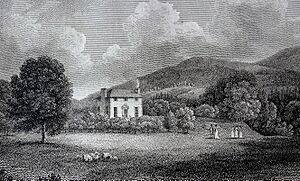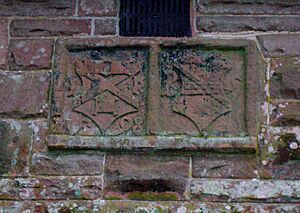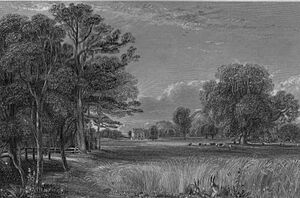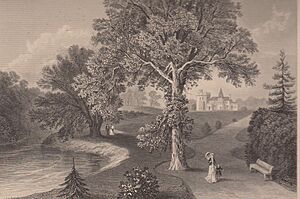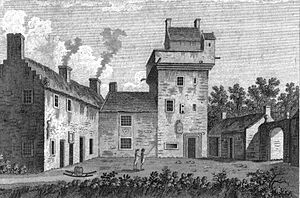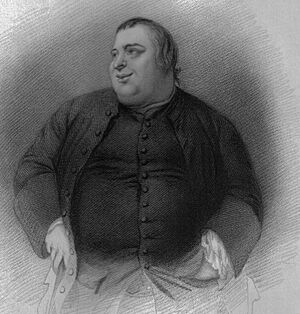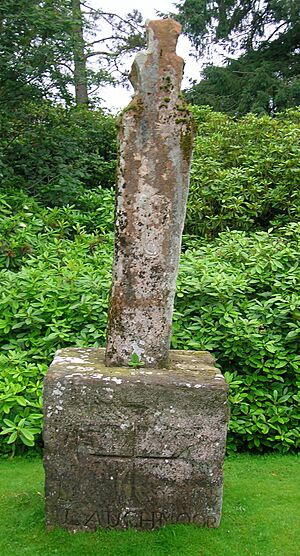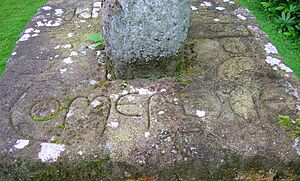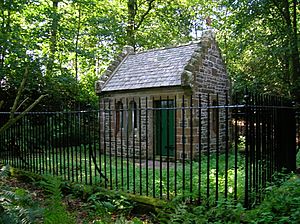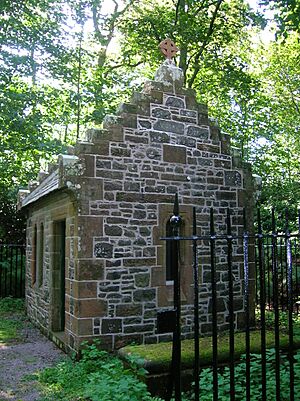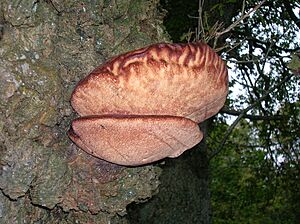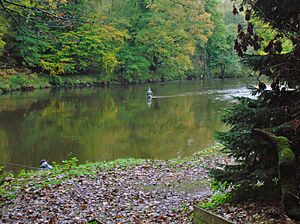Friars Carse facts for kids
Quick facts for kids Friars' Carse |
|
|---|---|
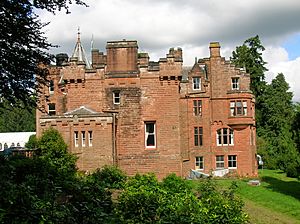
Friars' Carse
|
|
| Location | Auldgirth, Dumfries |
| Built | 1771, rebuilt 1873, extended 1909 |
| Built for | Robert Riddell |
| Architect | Barbour and Bowie (1873, 1909) |
| Architectural style(s) | Scots Baronial |
|
Listed Building – Category B
|
|
| Official name: Friars Carse former Stables including Beech Cottage | |
| Designated | 26 June 1986 |
| Reference no. | LB4234 |
| Lua error in Module:Location_map at line 420: attempt to index field 'wikibase' (a nil value). | |
Friars' Carse is a large country house and estate located about 2 kilometers (1.2 miles) southeast of Auldgirth in Scotland. It sits on the west bank of the River Nith. This place is famous because of its strong connection to the poet Robert Burns, who lived nearby at Ellisland Farm. While the main house itself isn't officially listed as a historic building, its old stables and a small building called the Hermitage are protected as Category B listed buildings.
Contents
- The House and Estate Grounds
- The Riddell Family
- Dr. James Crichton's Ownership
- The Nelson Family
- Friars' Carse as a Convalescent Home
- The Post Office Fellowship of Remembrance
- Ancient History of Friars' Carse
- Cultural History and Robert Burns
- The Laugh Moor Burial Stone
- The Hermitage
- The River Nith
- Friars Carse Country House Hotel
- Interesting Facts
- Images for kids
The House and Estate Grounds
Today, Friars' Carse is a hotel. It's built in a style called Scots Baronial, which looks a bit like a castle with towers and fancy stonework. The house was built in 1873 around an older building and then made even bigger between 1905 and 1909. It has a unique round tower and a special stone panel from 1598 built into its entrance. Inside, there's a beautiful entrance hall and a snooker room. The house has 21 bedrooms and is surrounded by 18.2 hectares (45 acres) of parkland and woods.
The name Friars' Carse comes from a group of monks called Cistercians. They had a settlement here in the 1200s. Nearby, there's a place called Carse Loch, which the monks used as a fish pond. It also had a crannog, which was an artificial island. This island was used to hide valuable things when there were wars or raids.
In the 1500s, there was a tower house here. Later, in the 1600s and 1700s, more buildings were added. In 1771, Robert Riddell tore down the old, ruined buildings to build a new mansion. A visitor in 1789 noted that the monks' old dining hall still stood, with very thick walls and a huge fireplace.
The Stables and Beech Cottage
These buildings on the estate were mostly built in the early 1800s. The main part of the stables was updated around 1873, with a tall tower added. The stables are made up of four single-story buildings around a square courtyard. There's also a special tower for doves, called a dovecote.
The Riddell Family

In the 1600s, William Riddell bought the lands of Friars' Carse. The older buildings were replaced by a simpler Georgian-style house in 1771-1773. This house was built for Robert Riddell, who was a good friend and supporter of the famous Scottish poet Robert Burns (1759–1796).
Robert Riddell's grandfather, Walter Riddell, inherited the estate through his wife, Anne. The Riddell family had owned the estate since shortly after the Reformation, when the lands held by Melrose Abbey became private property.
When Robert Riddell passed away in 1794, his wife decided to sell the property. This meant it left the Riddell family's ownership.
Dr. James Crichton's Ownership
After being sold by the Riddells, the estate was bought by Captain Smith, who then sold it to Dr. James Crichton in 1809. Dr. Crichton had become very wealthy through trade with China. In 1812, he moved into the house and changed its name back to Friars' Carse. He passed away there in 1823. His wife, Elizabeth Grierson, lived at Friars' Carse until she passed away in 1862. She helped found Crichton Royal Hospital in Dumfries in memory of her husband.
The Nelson Family
Elizabeth Grierson sold the estate to Mr. Thomas Nelson of Carlisle. He was an engineer who worked on the famous Forth Rail Bridge. Mr. Nelson made the mansion house much larger. He also made sure to keep interesting parts of the old building, like the "Whistle" room. He added symbols related to the Masons to the Hermitage building, because Robert Burns was interested in that group. Two stained-glass windows in the main hall show an anchor and chains, which might be a nod to his work on the Forth Rail Bridge.
Friars' Carse as a Convalescent Home
In 1895, the people in charge of the Crichton Royal Institution bought Friars' Carse. The mansion then became a place for people to recover and rest. It was used as a summer home for patients who could pay, often wealthy people. Some patients who couldn't pay also stayed there and helped as servants. The property was sold again in 1908.
The Post Office Fellowship of Remembrance
After being owned by Mr. Charles Wedderburn Dickson, who made the mansion even bigger, his widow sold the estate to a group called Bryn Asaph Ltd. This group was for Post Office staff. It became a place for Post Office workers to recover and have holidays. It was a memorial to the men and women of the Post Office who died in the two World Wars. The Post Office Fellowship of Remembrance (POFR Ltd.) still owns the estate today.
Ancient History of Friars' Carse

Records show that the lands of Carse were given to Melrose Abbey around 1215. The monks of Melrose Abbey may have had a farm here, which is why there's a place called 'Grange Mill' nearby. In 1536, the abbey's lands were given to John Kirkpatrick of Ellisland. By 1565, the property was owned by Thomas Kirkpatrick and his wife.
After the Reformation, the property went to the Kirkpatricks of Ellisland. They built a tower house here around 1595. When this tower house was taken down in 1773 to build the new mansion, the old dining hall walls were found to be 8 feet thick, and the fireplace was 12 feet wide!
Near the house was a loch, or lake, which was the monks' fish pond. In the middle of this loch was an artificial island called a crannog. It was built from large oak logs and planks. This was where the monks would hide their valuable things when the English invaded. A dugout canoe and other items were found when the loch was drained.
Friars' Carse was owned by the Stirlings for a while in the early 1600s, then by the Maxwells, and finally by the Riddells in 1737.
A very old cross, from the 800s or 900s, stands on a new base in the grounds. It's the only one left from a collection of stones that Captain Robert Riddell gathered. He even built a fake Stone Age circle of 38 weathered stones, which he called Templewood.
The lands of Carse once belonged to the Red Comyn in the 1300s. After he was murdered, the lands eventually passed to King Robert the Bruce. North of Friars' Carse, there's a spot believed to have been a camp built by the Roman general Gnaeus Julius Agricola.
Cultural History and Robert Burns
Robert Burns lived at the nearby Ellisland Farm from 1788 to 1791. He became good friends with Captain Robert Riddell and his wife. Burns wrote a poem called The Day Returns in their honor in 1788. He said he had "more pleasant evenings" at their home than anywhere else. Robert Riddell was a talented musician and historian.
In April 1791, Burns finished a collection of his poems and songs for Robert Riddell's library. These are now known as the Glenriddell Manuscripts.
Robert Riddell and Robert Burns also helped start the Monkland Friendly Society in Dunscore. Riddell was the president, and Burns was the secretary. This society had a library of 150 books and met regularly.
Burns mentioned Riddell's coin collecting in a poem from 1790:
|
Glenriddel, skill'd in rusty coins |
Robert Riddell found a gold ring with a pale blue stone near Friars' Carse in May 1791. Robert Riddell passed away at 39.
Annie Laurie
Alexander Fergusson married 'Bonnie' Anna Laurie, also known as Annie Laurie, in 1710. She is the famous "Annie Laurie" from the song. She lived at Craigdarroch for over 50 years but passed away at Friars' Carse on April 5, 1764, at the age of 81. Her grave's location isn't known, but she might be buried at Craigdarroch. She was a great-aunt of Robert Riddell.
Francis Grose
Francis Grose, a well-known historian, artist, and writer, stayed at Friars' Carse for a few months. He was visiting places in the area for his book, The Antiquities of Scotland. Grose became good friends with Robert Burns. Their friendship led to Burns writing his famous poem, Tam o'Shanter. Burns described his friend Grose as "Fine, fat, fodgel Grose."
The Whistle and Drinking Contests
On October 16, 1789, Robert Burns was at Friars' Carse for a famous drinking contest. Three landowners competed to see who could be the last person able to blow an ebony whistle. This event was made famous in Burns's poem The Whistle.
The winner, Alexander Fergusson, drank more than eight bottles of wine and was still able to stand and blow the whistle. Another participant collapsed, and Robert Riddell went to bed. The Duke of Buccleuch's judge oversaw the event.
The ebony whistle had been brought from Denmark by a courtier of Queen Anne's husband. The whistle had been the prize in earlier contests. In one contest, an ancestor of Robert Riddell won it from another family. The original Danish owner was a very large man who would challenge anyone to a drinking contest. Sir Robert Laurie won the whistle from him after a contest that lasted "three days and three nights."
Burns borrowed the ebony whistle a few days after the contest to show his friends. He also organized another drinking contest in Sanquhar with whisky. It's not known who won that one.
The Laugh Moor Burial Stone
On the old putting green at Friars' Carse, you can find a special cross. It's the only one left from Captain Riddell's collection, which included other old stones now at the Dumfries Museum. This cross, called the Laugh Moor cross, is thought to be a village cross from the 800s. It was a Celtic Cross, but its circle and arms are now broken. Later, it was used as a flat gravestone. The carving of shears on one side might mean the person buried there was a woman.
The square stone base it sits on is newer than the cross itself. It has a carved cross and the words 'Laugh Moor' on the front. The top of the base says, "Ora Pro Anima Comerchie De Laugh", which means "Pray for the soul of De Laugh foully murdered." When Robert Riddell found the cross, it was being used as a gate post.
The Hermitage
Captain Robert Riddell built a small summer house called the 'Hermitage' in a quiet part of the estate. It was close to Ellisland Farm. Robert Burns often used this peaceful spot to write poetry. He had a key to a gate that led directly from Ellisland to the Hermitage.
After Riddell passed away, the Hermitage was left to fall apart. By 1810, it was in ruins, with straw on the floor and broken trees around it. Only part of one wall was still standing by 1870. The name 'BURNS' was carved above the doorway.
Even though the original building is gone, Mr. Nelson of Friars' Carse built a new 'Hermitage' in 1874 on the same spot. It was recently restored in 2009 and now has information about its history.
Burns had written some lines on the window of the original Hermitage in memory of Robert Riddell:
|
Thou whom chance may hither lead, Life is but a day at most, |
The original window with these lines is now at the Ellisland Farm museum. The new Hermitage building once had these lines on its window too, but that window is now in the main mansion house.
The River Nith
The River Nith flows very close to Friars' Carse. The estate has about 2300 meters (1.4 miles) of riverbank for fishing. People can fish for salmon, sea trout, and grayling using different methods.
The riverbank is covered with woodlands. You can see many old and large oak trees here, especially the pedunculate oak. These old trees are home to interesting fungi, like the beefsteak fungus. There are also some notable old sycamore trees.
Friars Carse Country House Hotel
The old mansion house has been a country house hotel since 1938. It's set in 45 acres of woods and fields. Two small cottages at the old stable block have also been turned into places for visitors to stay. Friars' Carse is the only place on the River Nith that offers both fishing and accommodation.
Interesting Facts
An old summer house is shown on maps from 1855. The area where the putting green is now might have been the site of a monastery. There's a place called Oak Knowe near the stables. A spot called Deadman's Hole is on the other side of the River Nith from the mansion. Black Pool is a name for a part of the river upstream from the hotel. Brandyburn Farm, on the other side of the Nith, might have been a place for hiding illegal spirits. A statue and a seat are shown at the start of the path to the Hermitage. A small lake is shown near Carse Mains. A mill was located on the Mains Burn at Carse Mains, as shown on the 1855 map.
Images for kids


